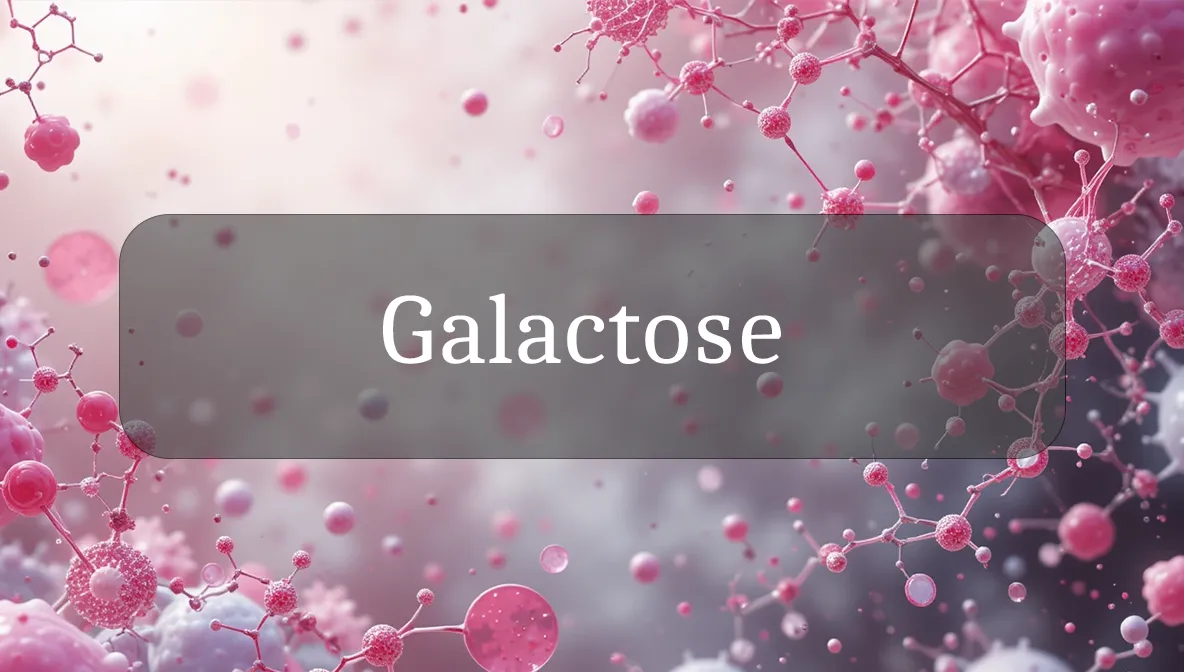Milk Sugar for Energy and Brain Health
Galactose is a natural sugar found in milk and dairy products, playing a key role in energy production and brain development. This guide explains what galactose is, its importance in your body, and practical ways to include it in a healthy diet, all in a clear and actionable way for daily wellness.
Chemical Identity and Type
Galactose is a monosaccharide, a simple sugar with the chemical formula C₆H₁₂O₆, similar to glucose. It’s primarily found as part of lactose (milk sugar), which is half galactose and half glucose. Your body breaks lactose into galactose and glucose using the enzyme lactase in the small intestine, then converts galactose into glucose in the liver for energy or other uses. Think of galactose as a versatile sugar that fuels your body and supports vital functions.
Biological Role and Benefits
Galactose has several important benefits:
- Energy Source: After conversion to glucose in the liver, galactose provides energy for cells, muscles, and the brain, supporting daily activities.
- Brain and Nerve Health: Galactose is a building block for glycolipids and glycoproteins, essential for brain development, nerve function, and cell communication, especially in infants.
- Bone Health: Found in dairy, galactose comes with calcium and vitamin D, promoting strong bones and teeth.
- Cellular Function: Supports the formation of connective tissues and cell membranes, aiding overall body structure and repair.
In moderation, galactose is a valuable nutrient, particularly for growth and development.
Dietary or Natural Sources
Galactose is mainly found in dairy products as part of lactose:
- High-Galactose Sources:
- Milk: Cow, goat, or human milk (~6g lactose per cup, half as galactose).
- Yogurt and soft cheeses: Kefir, ricotta, or cottage cheese contain moderate galactose (less in fermented products due to bacterial breakdown).
- Ice cream: Varies, but contains lactose and thus galactose.
- Low-Galactose Sources:
- Hard cheeses: Cheddar, parmesan, or Swiss have trace amounts due to aging.
- Butter and ghee: Minimal galactose content.
- Non-dairy foods: Fruits, vegetables, grains, and proteins (e.g., eggs, fish) are galactose-free unless processed with dairy.
- Hidden Sources:
- Processed foods (e.g., breads, cereals) or medications may use lactose as a filler, contributing small amounts of galactose—check labels.
- Galactose-Free Alternatives:
- Lactose-free milk (treated with lactase) or plant-based milks (e.g., almond, oat) are low or free of galactose but may lack dairy’s nutrients.
Choose dairy or fortified alternatives based on your digestive tolerance and nutritional needs.
Signs of Imbalance or Dysfunction
Issues with galactose arise from overconsumption, intolerance, or rare metabolic disorders:
- Lactose Intolerance (affects ~65% of adults globally):
- Bloating, gas, or diarrhea after dairy due to low lactase, limiting galactose breakdown.
- Abdominal cramps or nausea from undigested lactose fermenting in the gut.
- Galactosemia (rare genetic disorder, affects ~1 in 50,000):
- Inability to metabolize galactose due to enzyme deficiencies (e.g., GALT).
- Symptoms in infants: Vomiting, jaundice, poor growth, or liver damage after milk exposure.
- Long-term risks: Developmental delays, cataracts, or ovarian issues if untreated.
- Excess Galactose (uncommon):
- Overconsuming dairy in intolerant individuals may cause digestive discomfort or gut imbalance.
- In galactosemia, even small amounts of galactose are harmful, requiring strict avoidance.
If you notice digestive issues after dairy or suspect metabolic problems (especially in infants), consult a healthcare provider. Tests like breath tests or genetic screening can diagnose lactose intolerance or galactosemia.
Supporting Optimal Levels or Function
To harness galactose’s benefits while avoiding issues:
- Test Dairy Tolerance: Start with small amounts (e.g., ½ cup milk) to assess comfort. Many tolerate ~12g lactose (1 cup milk, ~6g galactose) without symptoms.
- Choose Low-Galactose Dairy: Opt for hard cheeses or yogurt with live cultures, which have less lactose/galactose and bacteria that aid digestion.
- Use Lactase Supplements: Over-the-counter lactase pills (e.g., Lactaid) can help digest lactose, releasing galactose without discomfort.
- Pair Dairy Smartly: Consume dairy with meals to slow digestion, improving galactose absorption. Avoid dairy on an empty stomach if intolerant.
- Explore Alternatives: Use lactose-free milk or fortified plant milks to get calcium and vitamin D without galactose if intolerant or galactosemic.
- Support Gut Health: Eat 25–35g fiber daily (e.g., fruits, veggies, whole grains) and fermented foods (e.g., kefir) to boost gut bacteria, which may ease dairy digestion.
- For Galactosemia: Strictly avoid galactose (dairy, hidden lactose) and work with a dietitian for a safe diet, especially for infants.
These strategies help you enjoy galactose’s benefits or manage restrictions safely.
Safety, Interactions, and Precautions
Galactose is safe for most people who digest lactose well, but precautions apply:
- Safety: Galactose from dairy is well-tolerated in moderation. Lactose intolerance causes discomfort, while galactosemia requires lifelong galactose avoidance.
- Interactions:
- Dairy may reduce absorption of antibiotics (e.g., tetracycline). Take medications 2–3 hours apart from dairy.
- Gut conditions (e.g., IBS, celiac disease) can worsen lactose/galactose digestion, causing bloating. Rebuild gut health with probiotics if needed.
- Precautions:
- If lactose intolerant, ensure calcium and vitamin D from non-dairy sources (e.g., fortified plant milk, leafy greens) to support bone health.
- Infants with galactosemia need galactose-free formula—consult a pediatrician immediately.
- Monitor processed foods for hidden lactose if intolerant or galactosemic.
Fun Fact
Galactose gets its name from the Greek word “gala” (milk), reflecting its starring role in dairy! It’s also a key player in your brain’s wiring, helping build the insulation around nerves for sharp thinking.
Citations
- National Institutes of Health. (2024). Galactose Metabolism and Galactosemia.
- Mayo Clinic. (2023). Lactose Intolerance and Galactosemia Overview.
- Cleveland Clinic. (2024). Dairy Nutrition and Digestive Health.
- World Health Organization. (2022). Nutrition: Dairy and Metabolic Health.
- USDA FoodData Central. (2025). Nutrient Database for Dairy and Galactose Sources.

